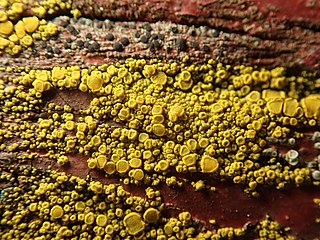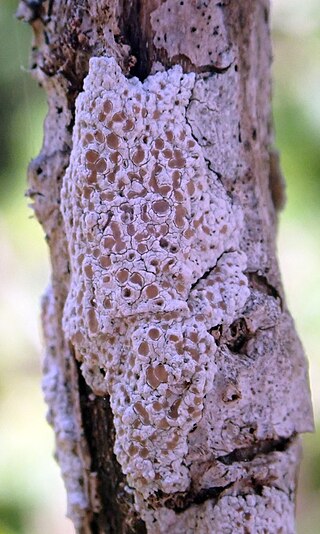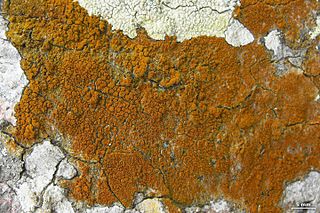
The Lecanoraceae are a family of lichenized fungi in the order Lecanorales. Species of this family have a widespread distribution.
Japewiella is a genus of lichen in the family Lecanoraceae. It was circumscribed in 2000 by German botanist and lichenologist Christian Printzen as a segregate of the genus Japewia. The genus name of Japewia was in honour of Peter Wilfrid James, who was an English botanist. The genus was circumscribed by Christian Printzen in Bryologist vol.102 on page 715 in 1999.

Vainionora is a genus of lichen in the family Lecanoraceae. The genus, which was circumscribed in 1991 by German lichenologist Klaus Kalb, honours the Finnish lichenologist Edvard Vainio, who described the type species as Lecanora pallidostraminea in 1890.
Traponora is a genus of lichen-forming fungi in the family Lecanoraceae. The genus was circumscribed in 2009 by Dutch lichenologist André Aptroot, with the Papua New Guinean Traponora asterella assigned as the type, and at that time, only species. Four newly described species were added to the genus in a 2009 publication, a species formerly in Pyrrhospora was transferred to the genus in 2017, and a new species from Australia added in 2018. Traponora lichens are predominantly from Australasia, with all species but one known to occur in Papua New Guinea.

Candelariella is a genus of bright yellow, ocher, or greenish yellow crustose or squamulose lichens in the family Candelariaceae. Members of the genus are commonly called eggyolk lichens, goldspeck lichens, or yolk lichens. The genus was circumscribed in 1894 by Swiss lichenologist Johannes Müller Argoviensis, with Candelariella vitellina assigned as the type species.

Rhizocarpon is a genus of crustose, saxicolous, lecideoid lichens in the family Rhizocarpaceae. The genus is common in arctic-alpine environments, but also occurs throughout temperate, subtropical, and even tropical regions. They are commonly known as map lichens because of the prothallus forming border-like bands between colonies in some species, like the common map lichen.
Lecanora printzenii is a species of crustose lichen in the family Lecanoraceae. Originally found in Spain, it was described as new to science in 2011. It shares several characteristics with lichens of the Lecanora varia group but is differentiated by its unique sequence in the internal transcribed spacer (ITS) region of its DNA and by several distinctive physical characteristics.

Lecanora strobilina, also known as the mealy rim lichen, is a species of crustose lichen in the family Lecanoraceae. It was originally described as Parmelia strobilina by German botanist Kurt Polycarp Joachim Sprengel in 1827. It is distributed across North America and the Mediterranean but has become established in South America and the Galapagos. It can be distinguished from other closely-related species in the genus by the presence of the polyphenolic compound decarboxysquamatic acid in thin-layer chromatography (TLC).

Palicella is a genus of crustose lichens in the family Lecanoraceae. It contains six species.
Lecanora solaris is a species of crustose lichen in the family Lecanoraceae. Found in the Altai Mountains in Russia, the lichen was described as new to science in 2019 by Lydia Yakovchenko and Evgeny Davydov. The lichen is similar in general morphology to Lecanora somervellii, but can be distinguished from that species by its small, squamulose (scaly) to marginally lobate umbilicate thallus and the persistent margin of its apothecia. The species epithet makes reference to the bright yellow colour of the lichen.

Lecanora kohu is a species of lichen in the family Lecanoraceae. Found in the Chatham Islands of New Zealand, it was formally described as new to science in 2017.
Klaus Kalb is a German lichenologist and an authority on tropical lichens.
Lecanora kalbii is a species of crustose lichen in the family Lecanoraceae. Found in the Galápagos Islands, it was described as a new species in 2020 by lichenologists Frank Bungartz and John Alan Elix. The specific epithet kalbii honours German lichenologist Klaus Kalb.

Sporastatia is a genus of crustose lichens in the family Sporastatiaceae. It has four species. Sporastatia lichens are long-lived species that grow on siliceous or weakly calcareous rocks in arctic and alpine locales.
Lecanora helmutii is a rare species of corticolous (bark-dwelling), crustose lichen in the family Lecanoraceae. Found in Tasmania, it was formally described as a new species in 2018 by Sergio Pérez-Ortega and Gintaras Kantvilas. The type specimen was collected from the eastern side of Stanley Highway, where it was found growing on the bark of Banksia marginata in a coastal swampy woodland dominated by Melaleuca. It is only known from the type collection. Other associated lichens include Austroparmelina pseudorelicina, Bactropsora paludicola, Menegazzia subpertusa, Pannaria elixii, and Parmotrema perlatum. The species epithet honours Austrian lichenologist Helmut Mayrhofer.

Lacrima is a genus of lichen-forming fungi in the family Teloschistaceae. It has four saxicolous (rock-dwelling), crustose species.
Fauriea is a genus of lichen-forming fungi in the family Teloschistaceae. The genus, which contains seven species, is a member of the subfamily Caloplacoideae.
Orientophila is a genus of lichen-forming fungi in the family Teloschistaceae. It has 15 species of mostly saxicolous (rock-dwelling), crustose lichens. All Orientophila species occur in Northeast Asia including China, Japan, South Korea, and the Russian Far East.
Fauriea trassii is a lichen species in the family Teloschistaceae, described in 2011. It is primarily found in the Far East of Russia, particularly in the Primorsky Krai region.









